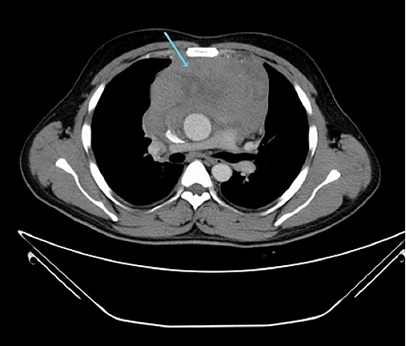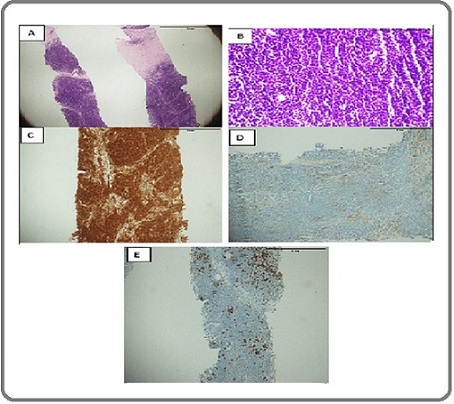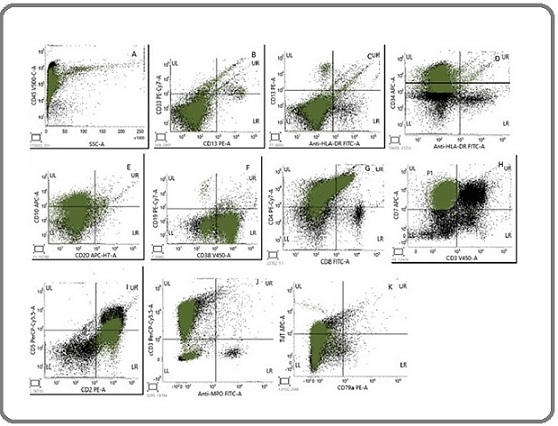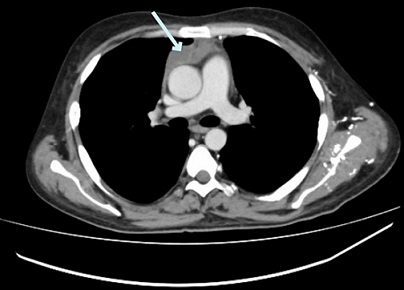Tackling the Rare: Thymoma and T-Cell Acute Lymphoblastic Leukemia Coexistence
Download
Abstract
Thymomas are rare tumors arising from thymic epithelial cells, while T-cell acute lymphoblastic leukemia (T-ALL) is a rare hematologic malignancy. The co-occurrence of these entities within the same patient is exceedingly rare and presents unique diagnostic and therapeutic challenges. We present a case of a 29-year-old male with a history of thymoma complicated by T-ALL. The patient was first presented with symptoms of superior vena cava obstruction syndrome, which led to thymoma diagnosis. Subsequent progression of symptoms and investigations revealed the presence of T-ALL. The patient was managed with chemotherapy, radiotherapy, and supportive care, with a favorable response. This case highlights the importance of considering rare malignancies in the differential diagnosis, the challenges of managing concurrent rare malignancies, and the need for multidisciplinary approaches in such cases. Further research is warranted to better understand the underlying mechanisms and optimal management strategies for these rare coexisting malignancies.
Introduction
Thymomas are rare tumors derived from thymic epithelial cells [1], often presenting with unique challenges and complexities in diagnosis and treatment. Concurrently, T-cell acute lymphoblastic leukemia (T-ALL) is an aggressive hematologic malignancy characterized by the clonal proliferation of T-cell precursors. The co-occurrence of these rare entities within the same patient is exceedingly rare, posing diagnostic and therapeutic dilemmas. We present a case of a 29-year-old male with thymoma complicated by T-ALL, emphasizing the challenges in diagnosis, management, and the need for multidisciplinary approaches in such complex cases.
Case Presentation
A 29-year-old male patient presented with a two-month history of a productive cough, dyspnea, and weight loss. He had a feeling of heaviness on his chest and was unable to lie down flat. A CT scan revealed a large, ill-defined anterior mediastinal mass with mediastinal lymphadenopathy and pericardial involvement (Figure 1).
Figure 1. CT Chest Showing: Anterior Mediastinal Mass.

A Tru-Cut biopsy confirmed thymoma (CD3+, TdT+. CD20+, CK+), and staging identified Stage IV disease with a 12 x 9 cm mass (Figure 2).
Figure 2. Histopathology (Core biopsy) of Anterior Mediastinal Mass Composed of Polygonal Cells with Mild to Moderate Cytological Atypia (A, B). These cells are positive for CD3 highlighting numerous T cells(C). CK positive in the thermic meshwork(D). CD20 positive in clusters of B cells (E).

While his workup was completed, he presented in the emergency department with a history of cough and worsening shortness of breath even at rest. The examination showed a marked pulse rate of 148, respiratory rate 48, and 91% saturation with 3 liters of oxygen requirement. He was urgently shifted to the ICU where a workup was initiated including echocardiography and repeat CT chest. He was diagnosed with Superior Vena Cava Obstruction Syndrome and underwent emergent radiotherapy due to the unavailability of stenting facilities. He completed 10 fractions of radiotherapy (Total Dose (cGy) 3000 to mediastinum. His symptoms got better, and he was later discharged with follow-up in the outpatient department. Within 1 month, he again presented to the emergency department with upper GI bleeding, melena, and hematuria. Lab results showed pancytopenia and a 43% atypical mononuclear cell population on peripheral smear. He developed Acute Kidney Injury and the underlying cause upon workup showed Tumor Lysis Syndrome. A staging CT scan revealed disease progression with bilateral retroperitoneal lymphadenopathy below the diaphragm and splenomegaly. Bone marrow biopsy and flow cytometry was done which confirmed Precursor T-cell acute lymphoblastic leukemia with 65% blast cell population (Figure 3).
Figure 3. Immunophenotyping by Flow Cytometry. Blast population (Green population) which is around 67% is positive for CD45(A), CD 13 and CD 33 negative (B), CD 13 and HLA-DR negative(C), CD 34 positive (D), CD 10 positive and CD 20 negative (E), CD 38 Positive CD 19 negative (F), CD 4 positive CD 8 positive (G), CD 7 positive surface CD 3 negative (H), CD 2 positive and CD 5 positive (I), cytoplasmic CD 3 positive MPO negative (J), TdT positive and CD79a negative (K).

Chromosomal analysis showed a normal male karyotype. His case was reviewed in tumor board and Treatment commenced with BFM 2000 Induction 1A chemotherapy. He had 2 admissions in induction with neutropenic sepsis secondary to E coli bacteremia. After Induction bone marrow was done including Measurable Residual Disease that was negative. He started on consolidation 1B protocol after the confirmation of remission. Consolidation was uneventful except for 2 delays due to low blood counts. There were no admissions. Bone marrow aspirate and Measurable Residual Disease were reported as negative post-consolidation chemotherapy. The patient developed a severe cough and felt distressed due to it. chest examination showed bibasal crackles. CT thorax was done which showed bilateral ground glass opacities with septal thickening. Pulmonary function tests that showed restrictive lung defects these changes were concluded to be due to radiotherapy. He was given symptomatic treatment with minimum benefit which included a short course of steroids. The patient was later started on Protocol M, and a restaging CT scan done for thymoma follow-up showed a reduction in thymoma size to 24 x 21 mm after following up with the medical oncology department (Figure 4).
Figure 4. CT Chest Showing Reduction in Size of Thymic Mass.

Protocol M was difficult due to severe mucositis with methotrexate requiring multiple delays. He is on protocol M with regular follow-up with hematologist and for thymoma with medical oncology team .
Discussion
The occurrence of rare malignancies within a single patient raises many challenges and questions that demand our attention and investigation. First, it is crucial to understand the origins of these malignancies. Thymomas or thymic carcinomas, originating from the thymus’s epithelial cells in the anterior mediastinum, are rare, with an annual incidence ranging from 0.13 to 0.32 per 100,000 people [1]. Typically, these malignancies affect individuals at the age of 50, and the prognosis is favorable, boasting an 87% 5-year survival rate [2]. Despite their rarity, there is a well-documented association with autoimmune disorders including myasthenia gravis (MG), pure red cell aplasia, acquired hypogammaglobulinemia, and connective tissue disorders [3]. Thymomas, intriguingly, also elevate the risk of solid malignancies like colon adenocarcinoma and thyroid cancer [4]. The co-existence of thymoma and T-cell acute lymphoblastic lymphoma is rarely described [5, 6]. One can only hypothesize that the long-standing untreated thymoma and the subsequent immune dysregulation or aberrant T-lymphocyte function may have partially caused the underlying leukemia genesis in this case. Additionally, even though chromosomal anomalies have been linked to thymomas [7], there are currently no sufficient explanations for the tendency of individuals with thymomas to be linked to clonal evolution.
This could be more challenging with type B1 because of their high lymphocyte content and little epithelial component. Therefore, immunohistochemistry- based identification of keratin-positive neoplastic cells might give a diagnostic clue [8].
Notably, Ki-67 labeling indices are rarely helpful in thymoma, and T-LBL/ALL typically exhibit elevated levels of Ki-67 expression [9].
The evaluation of distinctive cytogenetic or molecular abnormalities linked to T-lymphoblastic lymphoma/ leukemia, such as a monoclonal pattern of TCR-β and TCR-γ rearrangements by RT-PCR or specific mutations like NOTCH1/FBXW7 mutations which are frequently found in neoplastic T lymphoblasts as opposed to normal lymphocytes present in thymus, is another diagnostic tool [10].
Overall, the literature review provides an in-depth understanding of the diagnostic and treatment difficulties associated with thymoma and T-ALL coexistence. This case highlights the importance of interdisciplinary methods, continuous surveillance, and an extensive understanding of the variations associated with rare malignancies. The lessons learned from these experiences help to improve treatment plans and outcomes for individuals encountering these difficult barriers as medical knowledge evolves.
In conclusions, the coexistence of thymoma and T-ALL in our patient underscores the intricate interplay between immune dysregulation and oncogenesis. The rarity of such a dual diagnosis necessitates a comprehensive diagnostic workup, including histopathological, immunohistochemical, and molecular studies. Treatment requires a multidisciplinary approach, integrating chemotherapy, radiotherapy, and supportive care. This case highlights the importance of continuous surveillance, interdisciplinary collaboration, and ongoing research to improve outcomes for patients with rare malignancies. As we continue to unravel the complexities of these diseases, our insights will pave the way for more effective management strategies and better outcomes for patients facing similar diagnostic challenges.
Acknowledgments
Statement of Transparency and Principals:
• Author declares no conflict of interest
• Study was approved by Research Ethic Committee of author affiliated Institute.
• Study’s data is available upon a reasonable request.
• All authors have contributed to implementation of this research.
References
- Epidemiology of thymoma Rich AL . Journal of Thoracic Disease.2020;12(12). CrossRef
- Clinical and pathologic predictors of survival in patients with thymoma Wilkins K. B., Sheikh E., Green R., Patel M., George S., Takano M., Diener-West M., et al . Annals of Surgery.1999;230(4). CrossRef
- The spectrum of diseases associated with thymoma. Coincidence or syndrome? Souadjian J. V., Enriquez P., Silverstein M. N., Pépin J. M.. Archives of Internal Medicine.1974;134(2).
- Association between thymoma and second neoplasms Welsh J. S., Wilkins K. B., Green R., Bulkley G., Askin F., Diener-West M., Howard S. P.. JAMA.2000;283(9). CrossRef
- T-Lymphoblastic Leukemia/Lymphoma and Thymoma: A Case Report and Review of the Literature of a Rare Association Nadav Mizrahi , Eitan Kugler , Lucille Hayman , Moshe Yeshurun , Alon Grossman , Pia Raanani: Ofir Wolach . Acta Haematol 21 January.2022;145:106-111.
- Concurrent thymoma, thymic carcinoma, and T lymphoblastic leukemia/lymphoma in an anterior mediastinal mass Ito J, Yoshida A, Maeshima AM , Nakagawa K, Watanabe S, Kobayashi Y, Fukuhara S, Tsuta K. Pathology, Research and Practice.2015;211(9). CrossRef
- Pseudodicentric (16;12)(q11;p11.2) in a type AB (mixed) thymoma Goh S. G., Lau L. C., Sivaswaren C., Chuah K. L., Tan P. H., Lai D.. Cancer Genetics and Cytogenetics.2001;131(1). CrossRef
- Thymoma with loss of keratin expression (and giant cells): a potential diagnostic pitfall Adam P, Hakroush S, Hofmann I, Reidenbach S, Marx A, Ströbel P. Virchows Archiv: An International Journal of Pathology.2014;465(3). CrossRef
- Distinguishing thymoma from T-lymphoblastic leukaemia/lymphoma: a case-based evaluation Boddu P, Thakral B, Alhuraiji A, Pemmaraju N, Kadia T, Ohanian M, Ravandi F, et al . Journal of Clinical Pathology.2019;72(3). CrossRef
- The molecular basis of T cell acute lymphoblastic leukemia Van Vlierberghe P, Ferrando A. The Journal of Clinical Investigation.2012;122(10). CrossRef
License

This work is licensed under a Creative Commons Attribution-NonCommercial 4.0 International License.
Copyright
© Asian Pacific Journal of Cancer Care , 2024
Author Details
How to Cite
- Abstract viewed - 0 times
- PDF (FULL TEXT) downloaded - 0 times
- XML downloaded - 0 times